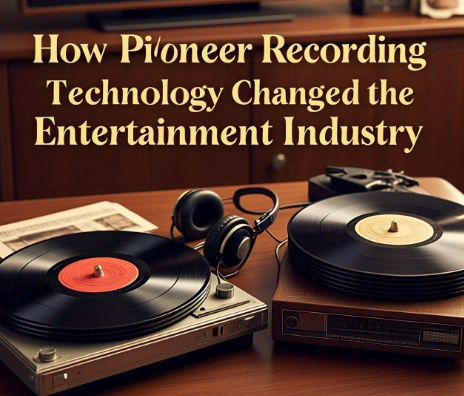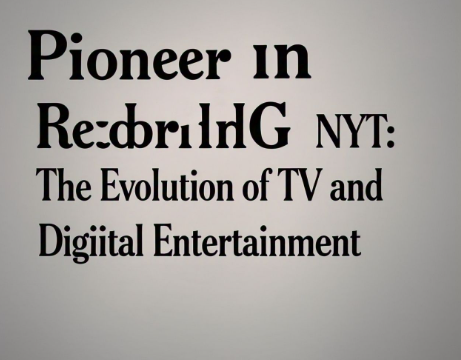Pioneer in show recording NYT has been an important term for those who love TV history and digital entertainment. The way people watch shows today is very different from the past, and this change started with early recording technology. From simple video recorders to modern streaming services, recording technology has shaped how we enjoy content.
The New York Times crossword puzzle recently featured the clue “Pioneer in show recording,” with the answer being TiVo. TiVo changed how people recorded and watched TV, allowing them to pause, rewind, and fast-forward live programs. But TiVo was not the first or only pioneer in show recording. Many other innovations have shaped the way we watch TV today. Let’s explore the history and impact of these pioneers.
Table of Contents
Pioneer in Show Recording NYT: How It All Started
Recording TV shows was not always easy. In the early days, people could only watch shows when they aired live. If they missed an episode, there was no way to watch it again. This changed with the invention of the videotape recorder (VTR) in the 1950s.
The first VTRs were large and expensive, mostly used by television stations. Later, the VCR (Video Cassette Recorder) became available for homes. This allowed people to record shows on tapes and watch them later. It was a big change because it gave people control over their viewing schedule.
In the 1990s, a major breakthrough happened with TiVo and digital video recorders (DVRs). TiVo made it easy to record shows without needing tapes. People could pause and rewind live TV, making watching more enjoyable. This was a big step in the history of TV recording.
The Rise of TiVo: A Game-Changer in TV Recording
TiVo was introduced in 1999 and quickly became popular. It allowed users to record shows automatically without using VHS tapes. This made recording simple and convenient for many households.
One of the best features of TiVo was its ability to pause and rewind live TV. Viewers no longer had to miss important scenes if they stepped away. It also had a smart system that could suggest shows based on a person’s viewing habits.
Despite its success, TiVo faced competition from cable providers who started offering their own DVR services. Eventually, streaming platforms like Netflix and Hulu made traditional DVRs less necessary. Even though TiVo is not as common today, it played a major role in changing how people recorded and watched TV.
Beyond TiVo: Other Innovations in Show Recording
TiVo was just one step in the evolution of show recording. Over the years, many other technologies helped make TV watching easier.
- DVRs from Cable Companies – Many cable providers started offering their own recording devices. These DVRs allowed people to record multiple shows at the same time and store them for later.
- On-Demand Services – Platforms like Netflix, Hulu, and Amazon Prime eliminated the need for recording. Viewers could watch their favorite shows anytime without needing a physical recording device.
- Cloud-Based Recording – Some services now offer cloud recording, where TV shows are saved online instead of a physical device. This makes it easy to watch from any device, anywhere.
These new technologies continue to improve how people access entertainment, making traditional recording devices less necessary.
The Impact of Digital Recording on TV and Streaming
Digital recording changed how people watch TV. Before DVRs and streaming, people had to plan their schedule around their favorite shows. Now, they can watch whenever they want.
One major impact is the rise of binge-watching. Instead of waiting a week for a new episode, viewers can watch an entire season in one day. This has changed how TV shows are made, with more focus on long storylines instead of individual episodes.
Streaming platforms like Netflix, Disney+, and HBO Max have also made recording less important. Since shows are available anytime, people don’t need to record them. This shift has reduced the demand for DVRs and cable subscriptions.
How Pioneer Recording Technology Changed the Entertainment Industry

Show recording technology did more than just help people watch their favorite programs. It also changed how TV networks and creators made content.
Before recording devices, networks had to focus on live TV ratings. Now, they also look at on-demand and streaming numbers. This has changed how they create and release shows, with many networks now offering entire seasons at once.
Advertising has also changed. With DVRs, people could skip commercials, forcing advertisers to find new ways to reach audiences. This led to more product placements in shows and different ad formats on streaming platforms.
Recording technology has made entertainment more flexible, giving people more control over how and when they watch.
From VCR to Cloud Recording: The Evolution of TV Recording
The journey from VCRs to cloud recording has been long and full of changes. Each new technology has made watching and recording shows easier.
Key Stages in the Evolution of TV Recording:
- 1950s-1970s: VCRs – Allowed people to record shows on tapes but required manual setup.
- 1990s: TiVo and DVRs – Made recording automatic and allowed pausing and rewinding live TV.
- 2000s: On-Demand Services – Platforms like Netflix made it possible to watch shows anytime.
- 2020s: Cloud Recording – Shows are stored online, making them accessible from any device.
With new technology, recording TV shows has become less common. But the pioneers in show recording have played an important role in shaping modern entertainment.
What’s Next for Show Recording? Future Trends in Entertainment Tech
Technology is always changing, and show recording is no different. New advancements continue to shape how people watch their favorite programs.
Future Trends in Show Recording:
- AI-Powered Recommendations – More platforms are using artificial intelligence to suggest shows based on what people watch.
- Interactive TV Experiences – Shows that let viewers make choices, like Netflix’s “Bandersnatch,” could become more common.
- Better Cloud Storage – More people may use cloud-based recording services instead of physical devices.
- Improved Streaming Quality – Faster internet and better technology will make streaming even smoother, reducing the need for recording.
Recording technology may not be as important as before, but it continues to evolve. The future of entertainment will focus on making content more accessible and personalized for viewers.
Conclusion
The pioneer in show recording NYT crossword clue reminded people of how much TV recording has changed. From early VCRs to digital DVRs and now cloud storage, the way people watch TV has evolved a lot.
TiVo and other recording technologies helped shape modern entertainment. Today, streaming services have made recording less necessary, but the impact of these pioneers remains. As technology continues to advance, the future of TV watching will become even more exciting and convenient.

